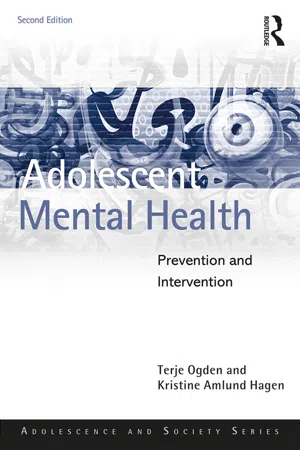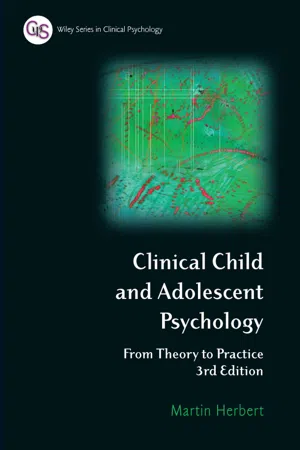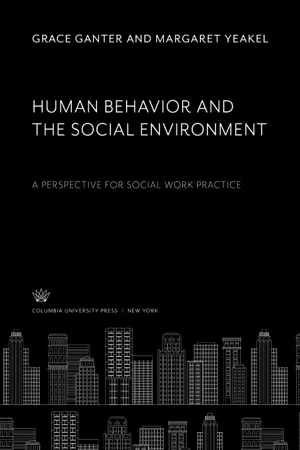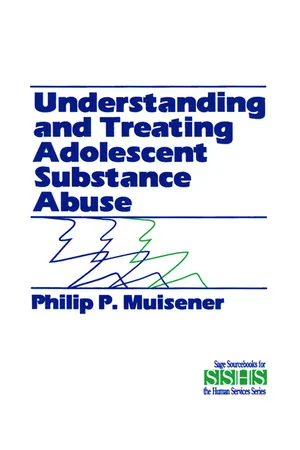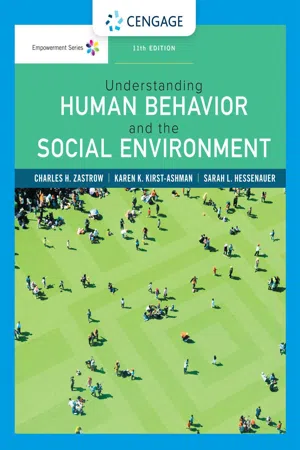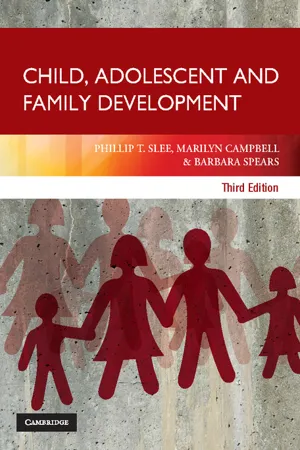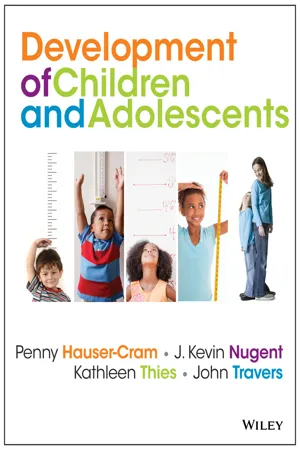Psychology
Adolescence
Adolescence refers to the transitional period between childhood and adulthood, typically characterized by physical, cognitive, and emotional changes. It is a time of identity exploration, increased independence, and the development of social and interpersonal skills. Adolescents often experience challenges related to self-esteem, peer relationships, and decision-making as they navigate this critical stage of development.
Written by Perlego with AI-assistance
Related key terms
1 of 5
12 Key excerpts on "Adolescence"
- eBook - ePub
Adolescent Mental Health
Prevention and Intervention
- Terje Ogden, Kristine Amlund Hagen(Authors)
- 2018(Publication Date)
- Routledge(Publisher)
1 Adolescent development What is Adolescence? Adolescence has been described as a period of life that starts in biology and ends in society (Kagan, 1975). This portrayal indicates that the onset of Adolescence is denoted by the hormonal changes of puberty, whereas becoming an integral part of one’s social environment marks the conclusion of this period of life. For many youths, however, the description is unfitting: whilst virtually all youths go through the biological transformations of sexual maturity and increased cognitive capacity, a significant proportion of young people do not end up in society ; rather, they become maladjusted and marginalized. Youths who become marginalized, that is, end up on the outskirts of society, are the very youths this book is about. They show maladaptive and dysfunctional behavior and they can teach us much about how to intervene and how to prevent such problems in future generations of adolescents. Adolescence is the period between childhood and adulthood and is often referred to as the teenage years. The period is divided into early (11–13 years), mid- (14–16 years), and late (17–19 years) Adolescence. Historically, Adolescence has expanded in length, probably due to teenagers’ increased time spent in school and decreased time spent in the work force during this period. Adolescence has been described as a period of reconstruction, characterized by significant changes in biological, cognitive, social, and emotional systems. To some extent, adolescent development is fairly predictable in the sense that most young individuals experience similar changes in multiple systems and face many of the same developmental challenges. Yet, in other ways, development is utterly idiosyncratic - eBook - ePub
Understanding the Life Course
Sociological and Psychological Perspectives
- Lorraine Green, Lorraine Green(Authors)
- 2016(Publication Date)
- Polity(Publisher)
Initially within this chapter, early psychological claims of Adolescence as a ‘naturally’ traumatic developmental stage are evaluated, followed by an analysis of physical, cognitive and psychosocial changes. In the latter sociological part of the chapter, psychology’s view of Adolescence as troubled is shown to have sustained enduring representations of young people as both dangerous and vulnerable. Youth transitions and historical changes in relation to employment and higher education are then analysed, followed by an examination of young people’s lifestyles and beliefs.Adolescence and psychology
Adolescence is generally accepted as a bio-psychological concept and often associated uncritically with white Western psychological understandings. G. Stanley Hall (1904), who was concerned mainly with misbehaving boys, initially conceptualized Adolescence as a biologically influenced ‘natural’ time of ‘Sturm und Drang’ or ‘storm and stress’, characterized by conflict with parents, mood disruptions and increased risk taking. This belief that Adolescence ‘exists’ as a universal, ‘naturally’ turbulent developmental stage or ‘normal maladjustment’ has strongly influenced sociological, psychological, media and policy understandings ever since. Consequently, there is concern for adolescents progressing through this stage ‘without showing some sort of disruption and turmoil’ (Fitzgerald, 2005: 795).Influenced by early philosophers such as Rousseau, Hall wrote of a metamorphosis between childhood and adulthood, puberty signifying a new birth, paralleling the evolutionary development of the human ‘race’ from savagery to perceived civilization. This genetically encoded experiential history was apparently recapitulated into individuals’ physiological and psychological development, Adolescence occurring when hormonal changes led to physical changes and psychological trauma before the onset of ‘mature’ adulthood. Later psychologists challenged Hall, claiming Adolescence for most was a relatively stable and untroubled period (Arnett, 1999; Coleman and Hendry, 1999; Herbert, 2008). Psychological problems in children and teenagers have, however, increased steadily since the early 1980s (Collishaw et al., 2004), but it cannot be assumed these are problems of - Michele Hoffnung, Robert J. Hoffnung, Kelvin L. Seifert, Abi Brooker, Sonja Ellis, Damien Riggs, Wayne Warburton, Elyse Warner(Authors)
- 2022(Publication Date)
- Wiley(Publisher)
PART 5 Adolescence Adolescence presents new and unique challenges and is a period of rapid and signifcant physical and cognitive development. Adolescents must come to terms with dramatic changes in their bodies as they mature sexually, and, for some teenagers, early or late puberty can make Adolescence especially diffcult. The emotional centres in teenagers’ brains are also maturing, and the need for increased stimulation brings with it signifcant threats to adolescents’ health and wellbeing in an environment that offers many novel and exciting experiences, which are also often risky. The transition to secondary education presents new intellectual challenges that test adolescents’ emerging skills in abstract thinking and, using their advanced cognitive ability, adolescents must formulate their own set of ethical principles to guide their behaviour. The power balance between caregiver and shifts as adolescents develop greater self-regulation, seek more control over their daily lives, and develop relationships outside of the family. In their push towards independence, adolescents begin a journey into autonomy that is usually not completed until sometime during adulthood. However, as emerging adults, adolescents must forge more equal relationships with their parents than was the case during childhood. Outside the family, the challenge of maintaining positive peer relationships extends into different-gender relationships, including aspects of sexuality and romance. This time in an adolescent’s life can cause confusion and confict, but these experiences can also be rewarding and fulflling. 10 Physical and cognitive development in Adolescence 447 11 Psychosocial development in Adolescence 496 Pdf_Folio:446- eBook - PDF
Clinical Child and Adolescent Psychology
From Theory to Practice
- Martin Herbert(Author)
- 2006(Publication Date)
- Wiley(Publisher)
Part IV Adolescence TO YOUNG ADULTHOOD EARLY Adolescence (11 TO 14 YEARS OF AGE): INTRODUCTORY BACKGROUND TO CHAPTER 10 Childhood ends with Adolescence. Adolescence refers to the psychological developments which are related broadly to the physical growth processes de fi ned by the term ‘puberty’. It is a stage of life that is not homogeneous; the tasks, preoccupations and cognitive maturity of adolescents vary to an extent that requires us to consider them clinically in terms of (i) early, (ii) middle and (iii) late Adolescence. The differences between 11 and 18 year olds, depending on individual development, are those between individu-als who, in body and mind, are still children, and persons who are in most respects young adults. The common but mistaken assumption that psychopathology is typical (even rampant) in Adolescence may lead to under-diagnosis of any real dif fi culties. If all teenagers are as ‘emotionally disturbed’ as was suggested by practitioners in the past, then the youngster who manifests some ‘dis-turbance’ must, by de fi nition, be typical, and therefore ‘normal’. In the 1930s Hutter, a psychiatrist, described Adolescence as a period of devel-opment ‘in which normally abnormalities so often happen it is abnormal that everything passes normally’ (Hutter, 1938). Anna Freud writing on Adolescence in the 1950s said it was ‘abnormal’ if a child kept a ‘steady equilibrium during the adolescent period… The adolescent manifesta-tions come close to symptom formation of the neurotic, psychotic or dis-social order and merge almost imperceptibly into… almost all the mental illnesses’ (Freud, 1958). The evidence from broadly based studies of adolescents in the com-munity (as opposed to clinic-attending samples) indicates that these gen-eralizations were undoubtedly exaggerated (see Herbert, 1987a, 1987b). Nevertheless, as many as one in fi ve adolescents do experience signi fi cant psychological problems. Among these problems are - eBook - PDF
Human Behavior and the Social Environment
A Perspective for Social Work Practice
- Grace Ganter, Margaret Yeakel(Authors)
- 2019(Publication Date)
- Columbia University Press(Publisher)
Chapter 8 Adolescence Adolescence designates that time in the life of the person between childhood and adulthood. During this time, the indi-vidual is no longer defined as a child and is not yet an adult. This is the period of youth, of transition from childhod to full adult membership in the society. Since these young people are neither children nor adults, they do not simply try to combine those relatively contradictory values and roles of childhood and adulthood to which we have previously alluded. They may develop values and whole complex sets of role behaviors of their own. Some may be free to experiment with social roles while others may be limited to stereotypical role behaviors. With others like themselves, most adolescents experience great loyalty and conformity. Peers become the most significant reference group for most young people. Firmly held beliefs and the feelings in which they have been anchored are frequently raised to consciousness and checked with peers, and social reality testing is encouraged and restrained by their mandates. The search for answers to the questions. Who am I? and Where do I belong? is implicated in behavior associated with close, often intimate, relationships with other young people and with uncertainty about commitment to adulthood. The development of the youth culture appears to be more anti-adults than is often the case. There are few rites of passage from childhood to Adolescence. Myths about adolescents can block people's reasoned concern for them. Many descriptions of their characteristics are given from the vantage point of adults who assume that all adolescents are Adolescence 185 the same and that there is an unchanging and thoroughly de-scribable kind of adult world into which all adolescents will enter. This period of youth is frequently seen as a waiting period during which young people learn the technical and interper-sonal skills of adults. - eBook - ePub
Cognitive Behavioural Therapy for Adolescents and Young Adults
An Emotion Regulation Approach
- Lawrence Howells(Author)
- 2018(Publication Date)
- Routledge(Publisher)
In today’s society, there are good reasons to adopt a broader age range. Firstly, many of the changes associated with Adolescence are beginning earlier; children appear to be entering puberty at a younger age than they did previously (see below) and many other aspects of Adolescence (such as sexual exploration) are beginning earlier, fuelled by changes in society and access to information (Bloch, 1995). Other aspects of Adolescence, however, are delayed and are occurring later than in previous generations. Across the developed world, for example, young people are spending increasing amounts of time in education and are also financially dependent on their families for longer. These societal changes do not impact equally across society and there is general consensus that the process of adolescent transition has become extended, pluralised, and fragmented (Coleman, 2011). Finally, research into brain development has found that the brain continues to evolve and develop in quite fundamental ways all the way through into the late 20s and early 30s (see below). Given this widening age range, some authors have tended to break down the period into smaller timeframes, for example early Adolescence, later Adolescence, and emerging adulthood (Patton et al., 2016).Given the level of individual difference in the rate of transition, it is perhaps imprudent to adopt rigid age ranges to define Adolescence. However, to give a rough idea about the population we are considering, Adolescence is considered in this book to cover the period between the ages of 10 and 25 years.It is important to outline this idea to clients, families, and other clinicians. Adolescence is not a phase of life that ceases abruptly upon turning 18, but is a more nuanced and gradual phase lasting into the twenties and often longer. Reference to brain research in relation to this explanation often adds significant weight to the argument! As individuals in their twenties tend not to identify themselves as adolescents, the term “adolescents and young adults” is used throughout this book.Physical development
Puberty is a period of physical development characterised by rapid changes in body size, shape, and composition. It produces the most rapid rate of linear growth since infancy and the greatest sexual differentiation since foetal life (Rogol, Roemmich, and Clark, 2002).Sexual maturation occurs during puberty under the influence of gonadal steroid hormones; primarily testosterone in boys and oestradiol in girls. The early stages of sexual maturation often involve the appearance of pubic hair, adult-type body odour, and occasionally acne. In boys, the first signs of formal sexual maturation are the thinning and reddening of the scrotum and the enlargement of the testes. This occurs on average around 111/2 to 12 years, although is considered normal between 9 and 14. Sperm production and ejaculatory capacity are present during early sexual development (on average around 131/2 years). - Philip P. Muisener(Author)
- 1993(Publication Date)
- SAGE Publications, Inc(Publisher)
Chapter 4 ADOLESCENT PSYCHOLOGICAL DEVELOPMENT AND SUBSTANCE ABUSE I N T R O D U C T I O N Adolescence is a period of psychological development unique from other developmental phases. Adolescent psychological development spans the period of time from puberty—often generalized as beginning around age 12—to incorporation of an adult identity, which occurs somewhere between the late teens into the 20s. This period of psychological life, in essence a recapitulation of the first 5 years of development, abounds with a rate of internal change not experienced since one's early child-hood and not to be experienced in adulthood. The nature of the adolescent years is change. The crux of the psycho-logical changes—the reorganizing of personality structure replete with new and intense affective states, a reordering of how one experiences internal representations of parents and peers, and an expanded sense of one's self—has been the source of much discussion and debate by child development theorists. For years the concept of sturm and drang —ado-lescence as a period of deep emotional turmoil—dominated the thinking in adolescent development. In more recent years, the emphasis on the normal aspects of adolescent psychological development has gained much acceptance (Offer, Ostrov, & Howard, 1981). Yet even this recent 58 ADOLESCENT PSYCHOLOGICAL DEVELOPMENT 59 emphasis toward thinking of adolescent development as more chaos-free has been met by challenging voices. The traditional view of normal Adolescence as a time of sturm and drang has been so thoroughly discredited that there is now a real danger of overstatement in the opposite direction—by denying that adolescent be-havior is significantly different from that of adults. While most adoles-cents are not disturbed (their incidence of mental illness is no higher than that of adults), objective indexes do suggest that Adolescence is not a time of utter stability.- Charles Zastrow, Karen Kirst-Ashman, Sarah Hessenauer, , Charles Zastrow, Karen Kirst-Ashman, Sarah Hessenauer(Authors)
- 2018(Publication Date)
- Cengage Learning EMEA(Publisher)
Editorial review has deemed that any suppressed content does not materially affect the overall learning experience. Cengage Learning reserves the right to remove additional content at any time if subsequent rights restrictions require it. Psychological Development in Adolescence 323 in their activities. In addition to play, a major fo-cus of their lives is school. Therefore, mastering academic skills and material is important. Those who do learn to be industrious master activities. Comparison with peers becomes exceptionally im-portant. Children who experience failure in school, or even in peer relations, may develop a sense of inferiority. Stage 5: Identity Versus Role Confusion Adolescence is a time when young people explore who they are and establish their identity. It is the transition period from childhood to adulthood when people examine the various roles they play (e.g., child, sibling, student, Catholic, Native American, basketball star) and integrate these roles into a per-ception of self, an identity. Some people are unable to integrate their many roles and have difficulty cop-ing with conflicting roles; they are said to suffer from role confusion . Such persons feel confused and un-certain about their identity. Stage 6: Intimacy Versus Isolation Young adulthood is characterized by a quest for inti-macy, which involves more than the establishment of a sexual relationship. Intimacy includes the ability to share with and give to another person without being afraid of sacrificing one’s own identity. People who do not attain intimacy are likely to suffer isolation. These people have often been unable to resolve some of the crises of earlier psychosocial development. Various types of intimate relationships and how people experience them will be discussed in more de-tail in Chapter 8. Stage 7: Generativity Versus Stagnation Mature adulthood is characterized by the crisis of generativity versus stagnation.- eBook - PDF
- Philip James, Catriona Kearns, Ann Campbell, Bobby nP. Smyth(Authors)
- 2013(Publication Date)
- CRC Press(Publisher)
9 CHAPTER 2 Adolescence: a time of great change Experimentation with substances typically commences during Adolescence. In order to understand the phenomenon of substance use, it is therefore essential to have a good understanding of the teenage years. CONSIDERING ADOLESCENTS AS APPRENTICE ADULTS Adolescence is that much-maligned period of the lifespan that lies between childhood and adulthood. It is a time of dramatic change. The pace of develop-ment, both in terms of physical growth and in the acquisition of social skills, is probably only comparable with the rapid developments that occur during the first year of life. As 10-year-old children we are entirely reliant on our parents to meet all of our basic needs. Our parents have great influence over our selection of peers and hobbies. By the time we reach 20, we are capable of managing a huge array of different social situations and challenges on our own. We have learned how to function independently in the complex world of adults. Therefore, the task as we journey through Adolescence is to pick up the skills to equip ourselves for independent adult life. People who are embarking on a period of skills acquisition are often called ‘trainees’ or ‘apprentices’. These terms imply that a person is learning a range of additional skills to allow them to take on a new and independent role. We suggest that it is appropriate to conceptualise adolescents as apprentice adults . Culture and Adolescence Notably, Adolescence differs from culture to culture and, indeed, within cul-tures it changes over the decades. 1 Societies vary in the amount of time they 10 ADOLESCENTS AND SUBSTANCE USE allow young people to develop the skills to move towards independence. In affluent Western cultures, it can be argued that Adolescence stretches into the early twenties as young people are given time to learn about themselves and the world before being required to take on the full burden of adult responsibili-ties. - eBook - PDF
- Lisa J. Cohen(Author)
- 2016(Publication Date)
- Visible Ink Press(Publisher)
Moreover, adolescents’ cognitive development allows them to understand abstract notions of values and of religious and political beliefs. The beliefs they endorse become an important part of their identity. This process of identity formation also relates to an excessive concern with peer acceptance. When one’s identity is in flux, the reactions of other people become that much more important. In other words, people who are unsure of their own identity tend to give their peers more power to define who they are, while those with a stable self-identity are less easily influenced by the opinions of others. What happens when there are social barriers to identity formation in Adolescence? n all cultures, it is a developmental task of Adolescence to move toward an adult role in society. What happens when such roles are not available? Perhaps the society is in disarray, due to war or political or economic chaos. Alternatively, certain subgroups of the population may be barred from productive participation in society, due to poverty, lack of education, and/or racial or ethnic prejudice. When constructive social roles are not readily available, destructive or antisocial group identities become viable alternatives. For example, disenfranchised youths (particularly young males) may be inducted into street gangs or criminal organizations. As such, psychological development in Adolescence is heavily dependent on the surrounding culture, more so than at any earlier period. What kinds of emotional changes do adolescents undergo? For many reasons, Adolescence is a time of intensified emotions. The upsurge in hormones, the changes in brain function, and the adolescent’s own psychological reactions to massive physical, cognitive, and social changes all contribute to this emotional upheaval. In fact, brain imaging research has shown that the amygdala, an emotional center of the brain, is more responsive to emotional stimuli during Adolescence than at any other time in life. - eBook - PDF
- Phillip T. Slee, Marilyn Campbell, Barbara Spears(Authors)
- 2012(Publication Date)
- Cambridge University Press(Publisher)
At the same time adolescents acquire a greater capacity for rational and abstract thought associated with risk-taking, limit testing and experimentation. For some individuals, youth, particularly early youth, represents a time of increased self-consciousness and egocentrism. Adolescents face major developmental landmarks, including achieving independence from parents, acquiring the rights to leave home and school, vote, have sex, drink alcohol and drive a car. At this time, many young people make signifi-cant decisions about their future careers. In contemporary Western countries such as Australia adolescents must also come to grips with other important issues that have implications for their future life. These include the uncertainty of employment oppor-tunities and the extended time that must often be spent at school as a result, health issues, and broader questions regarding the future such as conservation of the environ-ment and global warming. This chapter describes the theories of adolescent social and emotional development expounded by Freud and Erikson, and focuses on the special topics of peer groups, loneliness, friendship, unemployment, delinquency and attitudes towards institutional authority. The family life-cycle: 20 addresses the future prospects of today’s young people, touching upon the important consideration of wellbeing. Theoretical foundations As in other aspects of development, both Sigmund Freud and Erik Erikson have made significant contributions to our understanding of adolescent social and emotional development. Sigmund Freud We saw in Chapter 17 that according to psychoanalytic theory the primary schoolchild is in the latency period with regard to emotional development. This period is then fol-lowed in Adolescence by the genital stage ( Table 20.1 ). According to Freud, after the latency period the hormonal changes of puberty herald the re-emergence of sexual feelings. - eBook - PDF
The Development of Children and Adolescents
An Applied Perspective
- Penny Hauser-Cram, J. Kevin Nugent, Kathleen Thies, John F. Travers(Authors)
- 2013(Publication Date)
- Wiley(Publisher)
Psychosocial Development in Adolescence 603 hinders their ability to become self-reliant (Soenens & Vansteenkiste, 2010). Adoles- cents exposed to psychological control tend to resent and feel rejected by their parents (Roth, Assor, Niemiec, Ryan, & Deci, 2009). They may also show symptoms of de- pression and antisocial behavior (Barber et al., 2005). Table 16.4 gives some examples of how parents’ use of control can affect adolescents’ reasoning and their eventual behavior and sense of well-being. What about cultural differences? Some cultures use psychological control— especially guilt and shame—more often than others in parenting adolescents. Never- theless, the negative effects of psychological control on autonomy have been found in a wide range of cultures (Wang, Pomerantz, & Chen, 2007). Adolescent–Peer Relationships A well-known hallmark of the adolescent years is the growing importance of peer re- lationships. Compared with younger children, teens spend more time with peers, care more about peers’ opinions, and have more complex relationships with peers (Brown & Larson, 2009). In a classic study, Robert Selman (1981) asked children and adoles- cents, “What makes a good friend?” He found that friendships during the middle school years are based largely on enjoying activities with peers who have similar inter- ests. Friendships in the adolescent years involve new qualities of intimacy (Selman, Levitt, & Schultz, 1997). Recall from Chapter 15 that the ability to use abstractions improves during Adolescence. Consistent with that development, adolescents often speak of their friendships in terms of abstract qualities, such as trust, faithfulness, and intimacy (Smetana & Villalobos, 2009). One way to assess intimacy is to ask people about the emotional support they re- ceive from friends and family. Emotional support refers to sharing feelings, con- cerns, sympathy, and acceptance (Willis & Shinar, 2000).
Index pages curate the most relevant extracts from our library of academic textbooks. They’ve been created using an in-house natural language model (NLM), each adding context and meaning to key research topics.
